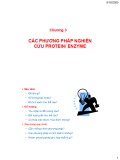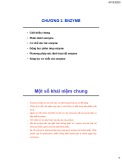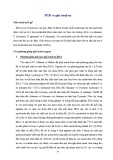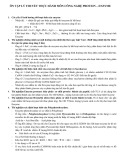
Enzymatic Processing in the Food Industry
Pedro Fernandes
a,b
,
a
IBB –Institute for Bioengineering and Biosciences, Instituto Superior Tecnico, Universidade de Lisboa,
Lisboa, Portugal; and
b
Universidade Lusófona, Lisboa, Portugal
© 2018 Elsevier Inc. All rights reserved.
A Brief Overview on Enzymes 1
Basics Considerations on Enzymes 1
Enzyme Classification 1
Enzymes in Food Processing 2
Overall Perspective 2
Relevant Enzymes in Food Processing 3
Hydrolases 3
Isomerases 8
Oxidoreductases 8
Transferases 9
Lyases 10
Concluding Remarks 11
References 11
A Brief Overview on Enzymes
Basics Considerations on Enzymes
Enzymes have been used for millennia in food processing, such as bread baking, brewing, cheese and wine making, although only in
the later decades of the 20th century, processes were developed that allowed the production in well-characterized formulations,
even at large scale (Kirk et al., 2002;Mishra et al., 2017). Enzymes are globular proteins that act as catalysts, thus they speed up
the rate of a reaction by lowering the energy of activation. Some enzymes require cofactors, small organic molecules or metal
ions, for catalytic activity. Unlike chemical catalysts, enzymes are natural in origin, operate under mild temperature and pressure,
display high specificity and are biodegradable (van Oort, 2010;Subin and Bhat, 2015). Biologically active enzymes can be obtained
from animals, microorganisms and plants, but microbial sources are favored. Microbial enzymes can be produced in high yield, in
relatively low-cost and short time processes, and are typically more stable than enzymes from the remaining sources. Particularly
preferred are microbial produced enzymes that are secreted to the fermentation medium, as this eases separation and purification.
Genetically modified microorganisms expressing exogenous enzymes (from plant or animal sources and from pathogenic or diffi-
cult to grow microbial strains) are also used in commercial enzyme production (Chandrasekaran et al., 2015;Subin and Bhat,
2015). Enzyme activity and stability are influenced by operational conditions, e.g., pH, temperature, substrate concentration, pres-
ence of metal ions and enzyme concentration. Enzymes have optimal pH and temperature conditions for activity and stability that
may not fully match in an industrial process. An increase in substrate concentration increases activity up to a given point, henceforth
the rate of reaction stabilizes or may even decrease, in case of substrate inhibition. Also depending on the enzyme, given metal ions
may be required for activity (e.g., Ca
2þ
for most a-amylases), or may inhibit enzyme activity (Subin and Bhat, 2015). Thus, careful
selection of operating conditions is critical for high enzyme performance. This is relatively easy to implement in laboratory condi-
tion with model systems, but may prove difficult to reproduce with real systems, due to the complexity of the matrix to be processed,
e.g., hydrolysis of lactose in buffer system or industrial scale hydrolysis of lactose in milk. Enzymes can be used in free form or
immobilized, e.g., attached to/entrapped in an inert support, to allow the repeated/continuous use of the enzyme, and to also
increase its stability. Still, the implementation of an immobilized enzyme based system at industrial scale requires a careful eval-
uation as in addition to technical issues, e.g., loss of activity during immobilization, mass transfer limitations, the economics of
immobilized enzymes, e.g., cost of immobilization, cost of immobilization carrier and chemicals for immobilization, must be
considered (DiCosimo et al., 2013;Sheldon and van Pelt, 2013).
Enzyme Classification
Enzymes are differentiated from one another by the type of reaction catalyzed, therefore this specific property is the basis for the
classification and naming of enzymes. A systematic approach was implemented in the 1960s to avoid confusion caused by the
increasing number of enzymes known, a few hundred then and over 5500 currently, which rendered the use of traditional and trivial
names unpractical (Cornish-Bowden, 2014;Subin and Bhat, 2015). The nomenclature established then, that still stands largely
unchanged, classifies each enzyme with a four-digit code preceded by EC, which stands for Enzyme Commission (Table 1).
The first digit is the most important since it ascribes the enzymes to one of six classes, which depend on the nature of reaction
catalyzed (Table 1). The second and third digits correspond to further divisions of each class in subclasses and of each of these in
1

sub-subclasses. Such divisions depend on noticeable differences of the enzymes in the class and subclass, respectively, and are
related to the type of reaction catalyzed, such as substrate acted on and groups transferred. The fourth digit identifies the individual
enzyme within a sub-subclass (Tipton and Boyce, 2000;Ako and Nip, 2012;Cornish-Bowden, 2014). Specific details can be found
on-line at Explodens (http://www.enzyme-database.org/) and Brenda (https://www.brenda-enzymes.org/), among other sources
(McDonald et al., 2009;McDonald and Tipton, 2014). Still, trivial names, which are either the original name, e.g., papain, pepsin,
rennet, or those that result of adding the suffix“-ase”to either the substrate or to the reaction type, e.g., inulinases, glucose isom-
erase, are commonly used and are the recommended names once ambiguity is ruled out (Subin and Bhat, 2015).
Enzymes in Food Processing
Overall Perspective
The use of enzymes in the food industry presents several advantages, namely: a) allows for high product yields; b) minimizes forma-
tion of by-products and unwanted side reactions, concomitantly easing downstream processing; c) leads to environmentally
friendly processes with low energy requirements and reduced carbon footprint; d) provides safe and high-quality products that
comply with the requirements of increasingly demanding public and regulatory agencies (Chandrasekaran et al., 2015;Mishra
et al., 2017). It is thus not surprising that the food and beverage area leads the application market for enzymes (Pellis et al.,
2018). Major goals aimed at involving the use of enzymes are given in Table 2.
Enzymes in the food industry have been typically assigned to the roles of processing aids or food additives (Chandrasekaran
et al., 2015), although the latter denomination is under debate and the alternative designation of ingredients is being considered
(https://ec.europa.eu/food/sites/food/files/safety/docs/fs_food-improvement-agents_enzymes-guidance-categorisation.pdf). In
any case, food enzymes are mostly used as processing aids, meaning that they are used during the production process and are
not present in the final product, or if so, have no technological effect in the final product. Some enzymes, such as invertase or lactase
can be used in both roles. Enzyme formulations used in the food industry are carefully scrutinized by regulatory agencies such as the
Table 1 Top-level classification of enzymes
Class Type of reaction catalyzed/comments
EC 1 (oxidoreductases) Oxidation-reduction, where electrons are transferred between molecules, e.g., oxidases,
dehydrogenases. Co-factor required, two-substrate reaction
EC 2 (transferases) Chemical group transfer between two molecules
EC 3 (hydrolases) Hydrolysis, e.g., hydrolytic cleavage of peptide and ester bonds among others. Strictly, it involves
group transfer to water, that is typically in excess. Under selected conditions many hydrolases
can catalyze the reversal counterpart of the hydrolytic reaction
EC 4 (lyases) Elimination reactions, where a group of atoms is removed from the substrate in a manner not
involving hydrolysis nor redox reaction
EC 5 (isomerases) Transfer of functional groups within a molecule to produce an isomer
EC 6 (ligases) Covalent bond formation between two molecules trough condensation reactions. ATP, adenosine
triphosphate, is required
Table 2 Intended goals encompassing the use of enzymes in food industry
Purpose of use References
Production of a given molecule, such as glucose from starch hydrolysis or
fructose out of isomerization of glucose
Hobbs (2009) and White (2014)
Adjusting the rheology of processed suspensions to established parameters,
e.g., reduction of the viscosity and clarification of fruit juices through
hydrolysis
Moelants et al. (2014) and Sharma et al. (2017)
Extraction of compounds, such as amino-acids, flavors and colorants,
assisted peeling of fruits and descaling of fish
Sowbhagya and Chitra (2010),Nielsen and Nielsen (2012),
Feng et al. (2013), and Poojary et al. (2017)
Modification of organoleptic properties, e.g., debittering of juices,
tenderizing meat, altering/adding flavor
Puri et al. (2008),Cheetham (2010),Bekhit et al. (2014a,b),
and Ni et al. (2014)
Altering functionalities towards intended food formulations Rajendran et al. (2009) and Ferreira-Dias et al. (2013)
Improving shelf-life Miguel et al. (2013)
Digestive aids, e.g., a-galactosidase (EC 3.2.1.22) degrades non-digestible
carbohydrates
such as raffinose and stachyose, preventing flatulence
Chandrasekaran et al. (2015)
Incorporation in biosensors to monitor food quality Economou et al. (2017)
2Enzymatic Processing in the Food Industry

Joint FAO/WHO Expert Committee on Food Additives (JECFA, http://www.who.int/foodsafety/areas_work/chemical-risks/jecfa/
en/), or the European Food Safety Authority (http://www.efsa.europa.eu/en/topics/topic/food-enzymes), through the issue of
adequate specifications (http://www.fao.org/ag/agn/jecfa-additives/docs/enzymes_en.htm). A key goal of these specifications is
to make sure that enzymes and remaining components of the formulations, e.g., stabilizers, are safe and according to good
manufacturing practices (Chandrasekaran et al., 2015;Subin and Bhat, 2015). Updated information on enzyme formulations
commercially available can be obtained from the Association of Manufacturers and Formulators of Enzyme Products (AMFEP),
at http://www.amfep.org/.
Practical applications of enzymes may require the action of a single enzyme, e.g., lactase that promotes the hydrolysis of lactose
in the production of lactose-free milk; or the concerted action of several enzymes, e.g., a- and g-amylases, pullullanase and glucose
isomerase in the production of high fructose syrup or a combination of amylases, lipases, oxidoreductases and xylanases in the
production of bread (Miguel et al., 2013;Chandrasekaran et al., 2015;Hua and Yang, 2015).
Alongside with its application in well-established food production and processing systems, enzymes are also playing a role
within the scope of functional foods, those that have a potential health benefit beyond basic nutrition, namely through the produc-
tion of prebiotics. These are compounds that are neither hydrolyzed nor absorbed in the upper part of the gastrointestinal tract so
that they reach the colon, where they can have a positive impact in the health of the host related to the modulation of the microbiota
(Corbo et al., 2014; Dominguez et al., 2014;Anadón et al., 2016). These are mostly non-digestible oligosaccharides, resistant to
digestion in the stomach and small intestine. Currently inulin, fructo-oligosaccharides (FOS), lactulose, and galacto-
oligosaccharides (GOS) are considered as established prebiotics, yet several other oligosaccharides are under evaluation
(Dominguez et al., 2014;Osman, 2016).
Hydrolases such as carbohydrases, proteases or lipases, are the most commonly used enzymes in food processing (Brown, 2011;
Ackaah-Gyasi et al., 2015;Ventura-Sobrevilla et al., 2015), yet enzymes from the remaining classes also find applications within the
scope of food processing, such as: glucose oxidase, EC 1.1.3.4, in bakery (Miguel et al., 2013); transglutaminase, EC 2.3.2.13, in
meat processing (Santhi et al., 2017); acetolactate decarboxylase, EC 4.1.1.5, in brewery (Choi et al., 2015); glucose (xylose) isom-
erase, EC 5.3.1.5, in the production of corn-based sweeteners (Tomasik and Horton, 2012); and L-amino acid ligases for the
synthesis of functional peptides, some of which can replace sodium chloride (Arai et al., 2013;Nandakumar and Wakayama,
2015). The latter class is currently, and by far, the least common in food processing. More detailed information on the features
of relevant enzymes in food processing and the rationale for their application is given in the following sections.
Relevant Enzymes in Food Processing
Hydrolases
Amylases
Amylases are widely known as starch degrading enzymes. Starch is composed of two polysaccharides, amylose and amylopectin.
Amylose is mostly a linear polysaccharide formed by a-1,4 linked D-glucose residues with very few a-1,6-branching points. Amylo-
pectin is highly branched, thus combining a-1,4 linked D-glucose with a-1,6 linked D-glucose residues. Amylases can be obtained
from microbial, animal and plant sources, but the former is preferred (Gopinath et al., 2017). They are divided in a,band g,
depending of the type of bond they cleave. a-Amylase (EC 3.2.1.1. a-1,4-D-glucan glucanohydrolase), typically a metalloenzyme
that requires calcium ions for activity and stability, catalyzes the endohydrolysis of a-1,4-glycosidic bonds in starch polysaccharides
containing three or more 1,4-a-linked D-glucose residues, releasing dextrins (Hua and Yang, 2015;Liu and Kokare, 2017).
b-Amylase (EC. 3.2.1.2, a-1,4-D-glucan maltohydrolase) catalyzes the hydrolysis of the a-1,4-glycosidic bonds in starch from the
non-reducing ends as to release successive maltose units. g-Amylase (EC 3.2.1.3., a-1,4-D-glucan glucohydrolase, commonly
known as glucoamylase or amyloglucosidase) instead hydrolyzes the a-1,4-linked D-glucose residues successively from the non-
reducing ends of starch and malto-oligosaccarides with the release of b-D-glucose. Moreover, g-amylase also hydrolyzes a-1,6-
and a-1,3-D-glycosidic in bonds in other polysaccharides, but at a much lower catalytic efficiency as compared to the main activity
(Divakar, 2013;Hua and Yang, 2015). Amylases are used in the starch industry in the production of corn syrups (maltose and
glucose syrups) and crystalline glucose, and in the baking industry, to generate fermentable compounds for yeast and reduce the
time of fermentation, to improve rheological properties of dough and ease its handling, to increase bread volume and softness,
and to intensify the color and flavor of bread as result of Maillard reaction over the reducing sugars formed. Furthermore, they
are used in brewing processes and fruit juice production, for the clarification of beer and fruit juices, and in the production of
fermentable sugars from residual dextrins in the production of light beer. A further use is in confectionary, where high-maltose
and high-glucose syrups produced by amylases are used for the manufacture of hard candies and soft cream candy (Simpson
et al., 2012;Miguel et al., 2013;Chandrasekaran et al., 2015;Hua and Yang, 2015;Sharma et al., 2017).
Cellulase
Cellulase refer to a multi-enzyme system required for the full hydrolysis of cellulose, a polysaccharide composed of b-1,4-glycosil
residues. Cellulase includes b-1,4-endoglucanase (EC 3.2.1.4), often simply referred to as cellulase, which catalyzes the endohydrol-
ysis of b-1,4 D-glycosidic bonds in cellulose and in b--D-glucans; cellobiohydrolase or exoglucanase (EC. 3.2.1.91, b-1,4-D-glucan
cellobiohydrolase), which also catalyzes the hydrolysis of b-1,4 D-glycosidic bonds but from the non-reducing end, releasing cello-
biose units; and b-glucosidase or cellobiase (EC. 3.2.1.21, b-D-glucoside glucohydrolase), which hydrolyzes cellobiose and releases
glucose from non-reducing ends of cello-oligosaccharides. Cellobiase has a key role in the cellulose hydrolysis, as both endo- and
Enzymatic Processing in the Food Industry 3

exo-glucanases are inhibited by cellobiose. In synergy with other enzymes such as pectinases and hemicellulases, cellulases disrupt
the structural integrity of the plant cell wall and enhance the extraction of the targeted molecules. Hence, they are used in any
process involving processing of plant based materials. Cellulases are used in wine and fruit juice production to ease the maceration
and accordingly, the extraction of pigments, flavor compounds and fermentable sugars and the extraction of juices. In bakery, cellu-
lase is used to break down gums in dough structure, making the rise of dough and flavor distribution more even, improve the
strength, elasticity and machinability of the dough and improve the crumb structure of the baked goods (Simpson et al., 2012;
Miguel et al., 2013;Niemann, 2017). Cellulases are also used for the extraction of nutraceuticals from plants. Nutraceuticals are
compounds from natural sources with additional health benefits, besides the nutrition role (Puri et al., 2012).
Glucanase
Alongside with cellulase (EC 3.2.1.4), laminarinase (EC 3.2.1.6., b-1,3(4)-endo-glucanase) which catalyzes the endo-hydrolysis of
b-1,3- or b-1,4-glycosidic bonds in b-D-glucans, are the most widely used exogenous glucanases in brewing processes. More recently,
the use of liceheninase (EC 3.2.1.73, b-1,3–1,4- glucan-4-glucanohydrolase), which cleaves b-1,4-glycosidic bonds adjacent to
b-1,3-bonds, has also gained relevance. These enzymes are typically added during mashing and ease the filtration of beer by
breaking down glucans which results in decreased viscosity and improves wort separation. Together with papain and a-amylase,
glucanases are used to control haze in different stages of the manufacture of fruit juices. Glucanases are also used in wine making
to enhance the release of aromatic compounds (Slaughter, 1985;Schauer and Borriss, 2004;Singhania et al., 2010;Simpson et al.,
2012;Ackaah-Gyasi et al., 2015).
Inulinases
Inulinases are enzymes that mostly hydrolyze inulin, a polyfructan, but also levan and sucrose. Inulinases can have either endo- or
exo-action. The former, endo-inulinase (EC 3.2.1.7. 2,1–b-D-fructan fructanohydrolase) catalyzes endohydrolysis of 2,1-b-D-
fructosidic linkages in inulin, resulting in the formation of fructo-oligosaccharides (FOS), used as prebiotics; the latter, exo-
inulinase (EC 3.2.1.80) hydrolyzes terminal, non-reducing 2,1- and 2,6-linked b-D-fructofuranose residues in fructans, and are
used in the production of ultra-high fructose syrups. Fructose is sweeter than sucrose and does not crystalize easily, hence it is
used as a sweetener in beverages and in confectionery (Singh et al., 2017).
Invertase
Invertase (EC 3.2.1.26, b-fructofuranosidase also known as sucrase) hydrolyzes terminal non-reducing b-D-fructofuranoside resi-
dues in b-D-fructofuranosides. It is essentially used for the hydrolysis of sucrose to glucose and fructose (invert sugar syrup). Invert
sugar syrup is used as sweetener in baking, beverage, canning and dairy processes. The good humectant properties of the syrup also
contribute to improved shelf-life in confectionery products. Within the scope of the latter, invertase is directly used to promote the
formation of soft fondant centers (Serna-Saldivar and Rito-Palomares, 2008;Simpson et al., 2012;Subin and Bhat, 2015). Under
adequate operational conditions (high initial sucrose concentration, pH, temperature, enzyme source) invertase displays trans-fruc-
tosylation activity, which enables the synthesis of short-chain fructo-oligosaccharides (scFOS) from sucrose. These scFOS are
a mixture of 1-kestose, nystose and b-1-fructofuranosyl nystose and are formed upon the cleavage of the b-1,2- glycosidic bond
of sucrose and the transfer of the fructosyl moiety onto an acceptor such as sucrose or a FOS. FOS are used several in food formu-
lations such as jam, ice cream and in beverages and confectionery applications (Khandekar et al., 2014;Khanvilkar and Arya, 2015).
Lactase
Lactase (EC 3.2.1.23, b-D-galactoside galactohydrolase) also known as b-galactosidase hydrolyzes the b-glycosidic bond of lactose
with the release of its monomers, glucose and galactose. Lactase is used for the hydrolysis of lactose in milk and whey. Lactose is
present in milk at roughly 4.7% w/v, which prevents the consumption of this food by a significant fraction of adult population that
suffers from lactose intolerance, unless it is processed with lactase. Moreover, lactose hydrolysis enhances the sweetness of the pro-
cessed milk and decreases the risk of crystallization during spray-drying of milk, whey and cream. Hydrolyzed whey syrup is used in
ice cream, milk desserts and sauces, and as a sweetener in cereal bars (Law, 2010;Fraatz et al., 2014). Lactase is also available as
digestive aid (Ianiro et al., 2016). Under adequate operational conditions (temperature, initial lactose concentration, enzyme
source, pH) lactase has also been shown to be able to carry out transgalactosylation reactions, where the galactosyl moiety released
during lactose hydrolysis is accepted by lactose. The trisaccharide formed can act as acceptor of further galactosyl moieties released
and so forth, so that a mixture of oligosaccharides, or galactooligosaccharides (GOS) can be synthesized. GOS are similar to human
milk oligosaccharides which are lightly sweet, heat resistant and they influence the large intestinal microflora. They are currently
used in infant formula and increasingly in milk and dairy products such as fermented milk, ice cream or lactic acid bacteria bever-
ages. Moreover, GOS can be used in fruit juices and soft drinks, desserts, bakery and jams (Sangwan et al., 2011;Tzortzis et al., 2012;
Osman, 2016).
Lipase
Lipase (EC 3.1.1.3. triacylglycerol acyl hydrolase) hydrolyzes triacylglycerols into free fatty acids and glycerol. Most of the lipases
operate at lipid–water interfaces enabled by a mobile lid domain located over the active site. Besides the standard reaction type
catalyzed, lipases catalyze other types of reactions, namely (trans)esterification, lactonization and polymerization, displaying
a high affinity to long chain substrates, as opposed to esterases (Divakar, 2013;Khan et al., 2017). Lipases are highly promiscuous
4Enzymatic Processing in the Food Industry

enzymes hence they have wide application within the food sector. In bakery processes, lipases are used to replace or supplement
emulsifiers, to improve the flavor of baked products by releasing short-chain fatty acids through esterification, to improve shelf-
life, softness and texture of baked goods in synergy with amylases and xylanases, to increase dough strength, stability and machin-
ability, and to improve and even crumb structure. Phospholipases have also been used in complement to lipases; however, their
application in baking is much more recent than that of amylases or proteases (Miguel et al., 2013;Guerrand, 2017). In dairy, lipases
are used for flavor enhancement in cheese products, to obtain specificflavors milk/vegetable oil/fat and to accelerate cheese ripening
(Jooyandeh et al., 2009;Guerrand, 2017). Lipases are also used for the production of cocoa butter alternatives through interester-
ification reactions involving edible oils (palm oil, soybean oil) (Abigor et al., 2003). The production of lipids with similarities to
human milk fat for incorporation in infant formula has also been done using lipases. Human milk fat substitutes (HMFS) have been
obtained through: acydolysis of cheap natural oils and fats with high amounts of palmitic acid at sn-2 position such as butterfat,
lard, palm oil or palm stearin and a source of free fatty acids, e.g., coconut oil, olive oil, soybean oil, rapeseed oil, or fish oils, rich in
u-3-polyunsaturated fatty acids (PUFAs); interesterification between oils containing palmitic acid at sn-2 position and vegetable oils
rich in oleic acid and/or PUFA. Overall, the former approach is preferred, and it is used in the production of the commercial brand
Betapol
Ò
, out of lard and soybean fatty acids (Ferreira-Dias and Tecelão, 2014;Guerrand, 2017). In egg processing, lipases are used
for the conversion of egg yolk phospholipids into lyso-phospholipids to increase the emulsion stability and enhance its perfor-
mance in dressings and mayonnaise related products (Guerrand, 2017). Degumming of edible vegetable oils, a process that consists
of the removal of phosphatides from the crude oil, to improve storage stability and ease downstream processing of the oil, is carried
out enzymatically with phospholipases (Casado et al., 2012;Guerrand, 2017).
Pectinase
Similar to cellulase, pectinase (or pectic enzymes) is a collective term that covers a set of enzymes that allow the degradation of
pectic substances, polysaccharides composed of chains of D-galacturonic acid linked by a-1,4- bonds, present in plant cell walls.
Pectic substances include pectic acids, a polymer of galacturonic acid, and pectin, where roughly 80% of the carboxyl groups of
the polymer of galacturonic acid are methyl-esterified (Khan et al., 2013).
Pectic enzymes are classified according to their activity. Pectinesterase (EC 3.1.1.11, pectin pectylhydrolase, also known as pectin
methylesterase), which hydrolyze the methyl ester bonds in pectin, resulting in pectate and methanol. Due to the release of meth-
anol, there are restriction to the use of pectinesterase in food processing. The action of pectinesterase eases subsequent depolymer-
ization activity of polygalacturonases towards the degradation of pectin and ease further processing of the materials, namely
facilitating extraction, maceration, filtration and clarification. The depolymerization implemented through the use of polygalactur-
onases involves the hydrolysis of the a-1,4-glycosidic bonds between D-galacturonic acid units in the unesterified polygalacturonic
backbone. Commonly used polygalacturonases are endopolygalacturonases (EC 3.2.1.15, a-1,4-D-galacturonan glycanohydrolase,
commonly known simply as polygalacturonase) which randomly hydrolyze a-1,4-D-galactosiduronic linkages in pectate and other
galacturonans; and exopolygalacturonase (EC 3.2.1.67, poly[-a-1,4-D-galacturonide] galacturonohydrolase) which release mono-
mers or dimers form the non-reducing end of the chain. Depolymerization can also occur through the action of pectin lyases, which
cleave the a-1,4-glycosidic bonds by b-elimination to produce 4,5-unsaturated oligogalacturonates. Pectin lyases can depolymerize
highly esterified pectin into small molecules without prior action of pectinesterase, hence the use of pectin lyases prevents
tampering with the polymer chain ester content, which is accountable for the aroma of fruits. As with polygalacturonases, pectin
lyases can cleave the polysaccharide chain either randomly with pectate lyase (EC 4.2.2.2., a-1,4-D-galacturonan lyase) and pectin
lyase (EC 4.2.2.10, (1,4)-6-O-methyl-a-D-galacturonan lyase), the latter acting preferably on highly methylated pectins, or by
releasing dimers from the reducing end with exopectate lyase (EC 4.2.2.9., a-1,4-D-galacturonan reducing-end-disaccharide-
lyase) (Yadav et al., 2009;Mojsov, 2016;Sharma et al., 2017). Commercially available enzyme preparations are a mixture of these
pectic enzymes (Pedrolli et al., 2009). Given their catalytic activities, pectic enzymes are naturally used when processing of cereals,
fruits and vegetables is involved. Thus, in combination with (hemi)cellulases, pectinases enhance the extraction of fruit juices, vege-
table oils, and aromatic compounds, therefore, they find applications in the production of edible oils, juices, wine and nutraceut-
icals. Pectinases are also used to decrease viscosity in fruit juices and to prevent jellification in the preparation of concentrated fruit
juices, to prevent haze formation and ease filtration in wine and fruit juices, to improve maceration of vegetables in the production
of pastes and purées, to speed up the fermentation of tea, and to remove the mucilage layer of the grain in the processing of coffee
beans (Pedrolli et al., 2009;Khan et al., 2013;Molina et al., 2015;Sharma et al., 2017).
Protease
Proteases (peptidase or proteinase) encompass a large array of enzymes that share the ability to hydrolyze covalent peptide bonds.
The resulting smaller peptides typically display novel properties, including solubility, gelation, emulsification, foaming and taste
(Liu and Kokare, 2017;Zeeb et al., 2017). An example of the advantageous use of these features is the production of protein hydro-
lysates, which can be included in human diet either for protein supplementation (e.g., energy drinks, sports nutrition, weight-
control diets) or for clinical application, as ingredients of functional foods (e.g., tackling metabolic syndromes such as short bowel
syndrome, hypertension by inhibiting angiotensin converting enzyme, ulcerative colitis; production of hypoallergenic infant
formula) (Clemente, 2000;He et al., 2013;Lafarga and Hayes, 2017). Proteases are among the most commonly used enzymes
in food processing and examples to illustrate this include the use of rennet (mostly chymosin, complemented by a minor amount
of pepsin) as a coagulant in the manufacture of cheese and the use of papain for meat tenderization (Sumantha et al., 2006;Law,
2010;Liu and Kokare, 2017).
Enzymatic Processing in the Food Industry 5






![Bài giảng Enzyme Công nghiệp [mới nhất]](https://cdn.tailieu.vn/images/document/thumbnail/2019/20190927/kuronato/135x160/2591569591154.jpg)

![Giáo trình Công nghệ Enzim Phần 2: [Mô tả/Định tính nếu cần]](https://cdn.tailieu.vn/images/document/thumbnail/2016/20160604/tangtuy14/135x160/1762485882.jpg)
![Giáo trình Công nghệ Enzim Phần 1: [Thêm Mô Tả Chi Tiết Hấp Dẫn Hơn Về Nội Dung]](https://cdn.tailieu.vn/images/document/thumbnail/2016/20160604/tangtuy14/135x160/2028746805.jpg)











![Đề cương ôn thi Phụ gia thực phẩm [năm hiện tại]](https://cdn.tailieu.vn/images/document/thumbnail/2025/20251120/kimphuong1001/135x160/63671763608893.jpg)




